 The Fischingen monastery was founded in 1138 by Bishop Ulrich II of Constance on the upper reaches of the Murg.
He populated it with Benedictine monks from the Petershausen Monastery in Constance. After an
initial period of prosperity, the Fischingen convent counted hardly more than 10 monks until the 17th century.
In addition to the care of the monastic life, they were responsible for the pastoral care in the surrounding communities and in Fischingen itself.
The Reformation led to the extinction of monastic life in Fischingen for several years. Abbot
Heinrich Stoll, who came from Zurich, converted to the new teaching in 1526 and married.
His example was soon followed by the other four monks.
The Fischingen monastery was founded in 1138 by Bishop Ulrich II of Constance on the upper reaches of the Murg.
He populated it with Benedictine monks from the Petershausen Monastery in Constance. After an
initial period of prosperity, the Fischingen convent counted hardly more than 10 monks until the 17th century.
In addition to the care of the monastic life, they were responsible for the pastoral care in the surrounding communities and in Fischingen itself.
The Reformation led to the extinction of monastic life in Fischingen for several years. Abbot
Heinrich Stoll, who came from Zurich, converted to the new teaching in 1526 and married.
His example was soon followed by the other four monks.

The re-establishment of the monastery was achieved in July 1540 at the Catholic Convention in Baden. The governor of the abbot of St. Gallen, Fr. Markus Schenkli, was appointed as the new abbot of Fischingen. After initial personnel and financial difficulties, the spirit of reform prevailed in Fischingen. The monastery experienced its heyday in the baroque era with an average of 30 monks. Under Abbot Joachim Seiler von Wil (1672-1688) the monastery church was rebuilt (1685-1687).
Abbot Nikolaus Degen von Lachen (1747-1776) is considered the great baroque building abbot of Fischingen. He extended the church by adding the rococo-style upper choir and had the symmetrically designed, beautifully shaped monastery buildings in the east and south of the square erected. In the west, due to the high debt burden of the monastery, the earlier buildings from 1577 and 1635 remained. Abbot Augustin Bloch von Oberbuchsiten (1776-1815) skilfully guided the monastery through the turmoil of the French Revolution and had the lower choir of the church redesigned in the early classicist style. The liberal-radical state upheaval of 1831 and the fateful Monastery Act of 1836 brought about a major turning point. Despite united and wise opposition, all Thurgau monasteries were finally abolished by the Thurgau Grand Council on 27 June 1848. Under the sign of the Enlightenment and an exaggerated rationalism, the monasteries were then considered to be remnants of bygone times to be eradicated.
In the referendum of 20 May 1973, the so-called exceptional article in the Federal Constitution on the establishment of new monasteries and the restoration of abolished ones was deleted. On August 28, 1977 the legal rebuilding of Fischingen Monastery could be solemnly celebrated.

the newly renovated monastery church
the monastery courtyard
Idda statue above her tomb.
Those who put their feet into the cenotaph (sham tomb, grave of honour without mortal remains) of St. Idda will be freed from foot problems and tiredness. How beneficial for the pilgrims, how terrible for poor Idda!
Poor Idda, here her image carved in stone on the cenotaph, probably does not enjoy the many unwashed feet in her grave. Note her expression on her face!
But she has received fresh flowers. It was Mother's Day. I don't know if there is a connection.
The monastery has a beautiful library hall and is otherwise equipped for seminars. Nevertheless, there are still some baroque rooms, like this one with the coat of arms on the walls.

The monastery receives pilgrims. There are 2 multi-bed accommodations with a total of 46 sleeping places available. For those who want to have it more luxurious, there are 25 double rooms (from the seminar facilities), which can also be used as single rooms.